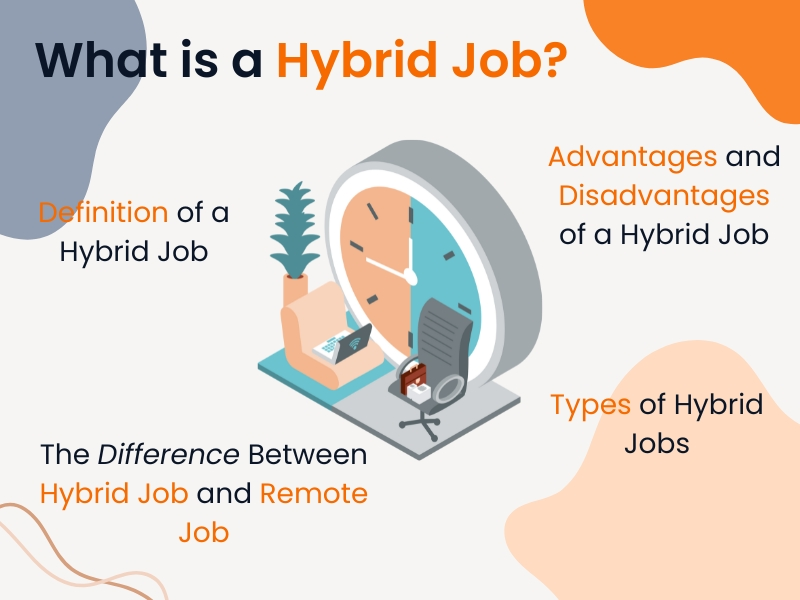
These days, the idea of a “hybrid job” is really gaining ground in the workforce. With new tech and changes in how we work, hybrid jobs are becoming more and popular with both employees and employers. This new way of working mixes traditional office settings with remote work, offering more flexibility and balance.
Definition of a Hybrid Job
A hybrid job is one where an employee can spend some of their time working remotely and some of their time in a traditional office setting. Hybrid jobs can be seen as a kind of middle ground between fully remote roles, which are done entirely from home or another location, and fully in-office jobs. This working style is flexible, letting employees work from home some days while also spending some time at the office for meetings, collaboration, or specific tasks that benefit from in-person interaction.
In a hybrid job, the number of days spent working remotely versus in the office can vary depending on the company’s policies or the employee’s responsibilities. Some companies might say you have to be in the office two or three days a week, while others let you decide where and when you work. The hybrid model is all about finding a better work-life balance and boosting productivity while still getting the benefits of face-to-face collaboration.
Types of Hybrid Jobs
Hybrid jobs can be set up in different ways, depending on what the business needs and what kind of jobs they’re doing. Different hybrid working methods differ according to the expectations of employees and employers.
- Scheduled Hybrid: In this type, employees are required to work a set number of days in the office and the rest remotely. For example, an employee may be in the office every Monday and Friday, while working from home on the other days. This model provides a predictable routine while still allowing employees flexibility.
- Flexible Hybrid: In this model, employees have the autonomy to decide when to work from home and when to come into the office, as long as they fulfill their job responsibilities. This is one of the most flexible hybrid job types, giving employees more control over their working schedule.
- Role-Based Hybrid: Some companies assign hybrid work based on the nature of the working role. For example, team leaders or managers may need to be in the office more frequently to oversee operations, while other employees, like developers or writers, may work remotely most of the time.
- Project-Based Hybrid: In certain companies, hybrid work might be organized around specific projects. Employees may come to the office when collaborating on a project but work remotely when performing tasks that require focus or individual effort.
Advantages and Disadvantages of a Hybrid Job
Despite the fact that hybrid work comes with a number of advantages, they also present a few difficulties. Before selecting whether or not this model is the best option, it is essential to consider both the positive and negative aspects.
Work-Life Balance
Hybrid jobs allow workers more flexibility in their plans, which can improve their ability to manage work and personal life. Employees may feel less stress and burnout when they have the option to work from home part-time, which helps them manage their personal responsibilities better.
Improved Employee Satisfaction
Providing hybrid work options has the potential to increase employee retention and happiness. Employees are frequently more engaged and motivated when they are given the freedom to choose their own schedule and work environment.
Increased Work Productivity
Many employees indicate that having the ability to choose their working environment makes them more productive. Working from home reduces distractions and allows for more focused work, whereas the office facilitates cooperation and meetings.
While there are many advantages offered by the hybrid working model, there are also disadvantages in some cases.
Communication Obstacles
Hybrid jobs can make communication and collaboration harder, especially if team members are working from different locations. There’s a chance of miscommunication, which could lead to delays or misunderstandings in the workplace.
Risk of Isolation
People who work remotely more often might feel like they’re out of the loop when it comes to the company culture or their colleagues. That can lead to feelings of isolation or less teamwork. “10 Tips to Improve Employee Engagement in Workplaces” can be useful to solve this problem.
Work-Life Boundaries
Hybrid jobs can be considered super flexible, but some employees might find it tough to set boundaries between work and personal life, especially when working from home. This can result in overworking or difficulty disconnecting from work.
The Difference Between Hybrid Job and Remote Job
It must be acknowledged that there is a common misconception between hybrid work and remote work. They are, in fact, two distinct models with unique characteristics.
The primary difference between the two remote and hybrid work is the flexibility of the work environment. Hybrid work unites the best of both worlds: the flexibility of remote work and the collaboration of an office setting.
Employees can split their time between the two, based on company policies or personal preferences. This model offers the best of both worlds: the flexibility of remote work and the in-person collaboration of office time. In contrast, remote work is a job where employees work entirely outside the office, typically from home or another chosen location, without ever having to visit the office.
Communication in remote jobs is conducted through digital platforms like email, video calls, or messaging apps. While remote work offers the ultimate in location flexibility, hybrid work strikes a balance by offering both flexibility and structured opportunities for face-to-face interaction, which helps to foster a sense of community and teamwork.
Today’s workforce favors hybrid occupations that allow workers to work remotely and in-office. Understanding hybrid job types and their pros and cons can help employees and employers establish a productive, healthy workplace.


